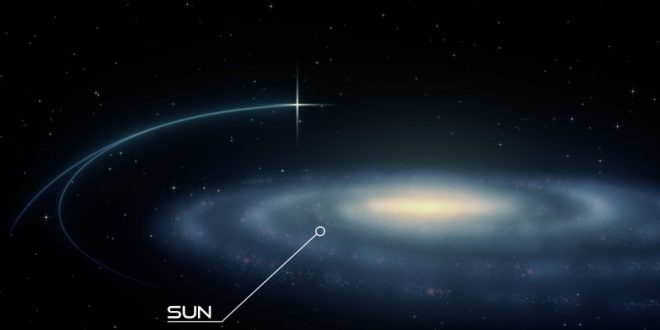Thousands of light-years away, on the outskirts of the Milky Way, astronomers have detected something no one’s ever seen before – a binary star (two stars orbiting a common centre of mass) that’s moving so fast, it’s clocked speeds that almost rival the escape velocity of our galaxy.
The binary system is called PB3877, and at 18,000 light years away from us, it’s not exactly in our neighborhood. It’s out past the Scutum-Centaurus Arm, past the Perseus Arm, and even the Outer Arm, in an area called the galactic halo. This binary star also has the high metallicity of younger stars, rather than the low metallicity of the older stars that populate the outer reaches. So PB3877 is a puzzle, that’s for sure.
PB3877 was first reported to be a hyper-velocity, hot compact star, when it was discovered form the Sloan Digital Sky-Survey (SDSS) data in 2011.
New spectroscopic observations were done with the 10 meter Keck II telescope at W. M. Keck Observatory on Maunakea, Hawaii and with the 8.2 meter Very Large Telescope (VLT) of the European Southern Observatory (ESO) in Chile.Caltech astronomers Thomas Kupfer and Felix Fürst observed PB3877 with the ESI Instrument fitted on the Keck II telescope.
“When we looked at the new data, much to our surprise, we found weak absorption lines that could not come from the hot star,” Kupfer said. “The cool companion, just like the hot primary, shows a high radial velocity. Hence, the two stars form a binary system, which is the first hyper-velocity wide binary candidate.”
The surface of the hot compact star is more than five times hotter than the Sun, while the companion is a thousand degrees cooler than our Sun. The system was determined to be 18,000 light years away. The mass of the hot compact star is only half of the mass of our Sun, and the companion is .7 times the mass of the Sun.
“We studied hyper-velocity stars since 2005, the year of discovery of the first three,” said team-member Ulrich Heber. “In the meantime about two dozen have been found, but all are single, none has a companion directly visible in its spectrum.”
The center of our galaxy hosts a supermassive black hole that can accelerate and eject stars from the galaxy by disrupting an original binary star. Hence, most hyper-velocity stars are believed to originate from the galactic center.
“From our calculations we can exclude the Galactic Center as the place of origin, because its trajectory never came close to it,” said team member Eva Ziegerer, specialist in stellar kinematics who collected the astrometry data and reconstructed the orbit of the binary. “Other ejection mechanisms, such as stellar collisions and a supernova explosion have been proposed, but all of them would lead to the disruption of a wide binary.”
“PB3877 may be an intruder from another galaxy,” Németh said. “In that case its prolonged gradual acceleration would not harm its integrity. The outskirts of our Galaxy contain various stellar streams that are believed to be the remnants of dwarf galaxies that were torn to shreds by the strong tidal force of the Milky Way.”
Unfortunately, the available data do not allow to make a connection to any of the known streams. Therefore, the origin of the binary remains unclear and so is its future. Whether or not the system remains bound to the Galaxy depends on the amount of dark matter in the Galaxy. Therefore, the mere existence of this binary puts pressure on our models and on our current understanding of dark matter in the Milky Way.
“We used different mass models to calculate the probability that the star will actually remain bound to the Galaxy. Only for the most massive Galaxy model this is the case. This makes PB3877 an excellent target to probe dark matter halo models,” said Andreas Irrgang, research associate at the Dr. Karl Remeis-Observatory.
The research continues with high-resolution spectroscopy to confirm the orbital properties of PB3877 and with a photometric follow-up to search for variability. “By finding further stars or binaries on similar orbits would indicate an external origin. Therefore, our quest for similar strangers will continue,” Németh said.
The W. M. Keck Observatory operates the largest, most scientifically productive telescopes on Earth. The two, 10-meter optical/infrared telescopes near the summit of Maunakea on the Island of Hawaii feature a suite of advanced instruments including imagers, multi-object spectrographs, high-resolution spectrographs, integral-field spectrographs and world-leading laser guide star adaptive optics systems.
Agencies/Canadajournal

 Canada Journal – News of the World Articles and videos to bring you the biggest Canadian news stories from across the country every day
Canada Journal – News of the World Articles and videos to bring you the biggest Canadian news stories from across the country every day

